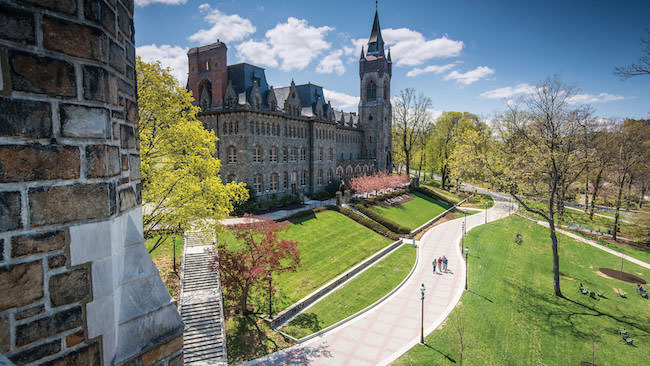
Lehigh University’s $46,702 per-student debt average is highest among reporting schools in Poets&Quants’ survey
‘THROW IT ON THE TAB’ MENTALITY
Thakkar says Illinois offered students resources for understanding personal debt, but as a business student, he didn’t feel compelled to utilize them. That’s a sentiment echoed by Ryan Rademann, member of the Class of 2014 of the No. 12 University of Minnesota Carlson School of Management, who himself graduated with more than $50,000 in debt.
Rademann, a Wisconsin native who now works for consulting tax and accounting firm Wipfli, tells P&Q that he had a stack of job offers by October of 2013, making debt a secondary concern.
“I was a finance major, so I didn’t feel unprepared to deal with it,” he says. “If I think about the problem of college debt, I don’t think the size of the debt is the problem. I think the problem is a lack of understanding. When you’re in college you really get this ‘throw it on the tab’ mentality. … I don’t think Minnesota did a great job of educating us on what it means to have that much debt, what a monthly payment looks like over a 10-year plan. But I can’t say that they do any worse of a job than any other school.”
Nor is debt burden always entirely from tuition, Rademann points out. With FAFSA (Free Application for Federal Student Aid) “you borrow as much as you say you need,” including for such things as apartment rent, and students often are faced with high interest and high fees.
‘WELL-PREPPED AND WELL-GROOMED’
Forty-eight percent of Carlson grads have debt coming out of school, according to statistics provided to P&Q by the school, with an average of $25,664. That’s mitigated, Rademann says, by the nature of the student who chooses to pursue a business degree.
“You come out of business school and it’s still just a bunch of college kids that drink too much,” he says. “And you see people about a year into their careers go through a pretty amazing transformation. We’re well-prepped and well-groomed in a business undergraduate program, and you don’t really know what real life is gonna look like after that — but as it turns out, a lot of it has to do with the caliber of the students that get into the program, that manage to get decent grades throughout the program, and that are diligent enough to get interviews and job offers before they graduate. A lot of it is just the people, but at the end of the day the program really did set you up as well as they possibly could to understand what the job market looked like, to understand what employers were looking for and wanted to hear …
“So I and almost everyone I graduated with had a stack of job offers coming out of school, and they were all making $60,000 or $70,000 or $80,000, and two years later a lot of them are working their way to having $100,000 in salary by the age of 25. I’m lucky in that I picked a major, I picked an industry and excelled in the industry with high earning potential and potential growth.”
THREE PROBLEMS WITH FINANCING IN HIGHER EDUCATION
For Louis Beryl, CEO and founder of Earnest, a student loan refinancing company, the issue of student debt is personal. Beryl relates his own story of graduating from Harvard with an MBA and a master’s in public policy — and a mountain of debt, the full amount of which he’d rather not divulge. He launched his San Francisco-based startup in 2013 and by 2014 had secured $15 million in venture capital backing; the next year Earnest received another $92 million in funding, plus $200 million in loan capital from New York Life.
As Beryl tells Poets&Quants, he’s not just Earnest’s CEO. He’s also a client. So he did what his company has advised countless other graduates to do since then: He refinanced his student loan to get the lowest rate he could, and he picked a monthly payment amount that was the highest he could sustain within his budget while also allowing him to save for retirement, and he wound up with the lowest interest rate possible.
“My personal opinion on higher education is that the costs are rising too quickly,” Beryl says. “The second problem is that in many cases, the cost is not worth what people are receiving. In many cases, the cost is worth it — but in a good percentage of cases, on average the return on that education is low.
“And the third problem is, students are unfairly positioned with regards to the cost of their education. What I mean by that is, if you’re a high schooler or even going to grad school, you’re trying to get into the best educational institution you can, but once you get in, basically the cost is what it is. The costs aren’t regulated very much — they can raise that cost on you however much they want the next year, and you have very little negotiating power, so to speak. Essentially you’re captive to the school, and that’s unfair from the student’s perspective.”
MORE OVERSIGHT
This is where the government could play a more active role, Beryl says: in monitoring both the increases in the cost of education and the total cost versus return by individual schools.
“Some schools have very high job placement rates,” he says, “and you would argue the cost of their education is probably more worth it. But there are some schools that aren’t giving their students same edge in the job market as others, and I think there should be more governance on schools’ ability to charge what they charge their students.”
More oversight — but if a school is producing students who nearly all get employment in the best jobs, Beryl says, it would make sense that it comes at a premium. But I think you have to strike that balance.”
(See the final page for a complete list of P&Q’s top undergraduate business programs and their student debt averages.)












Questions about this article? Email us or leave a comment below.